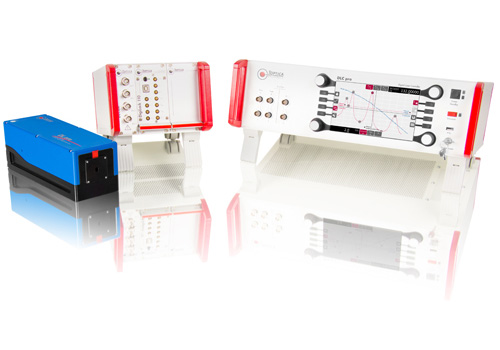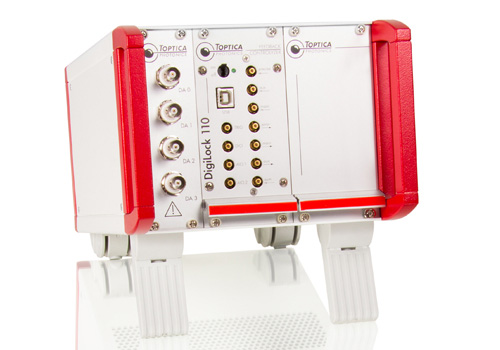
- Offer Profile
TOPTICA Photonics – Your outstanding laser provider
TOPTICA has been developing and manufacturing high-end laser systems for scientific and industrial applications for 20 years.
Founded in 1998 near Munich (Germany), TOPTICA became one of the leading laser photonics companies by aiming for, and consistently delivering high-end specifications. TOPTICA’s diode lasers are appreciated for excellent coherence, wide tuning range and ideal beam profiles.
High-end laser systems for scientific and industrial applications

- TOPTICA's cutting edge laser systems combine world class specifications with highest precision, reliability and longevity. By providing high-power lasers even at exotic wavelengths TOPTICA is renowned for the widest wavelength coverage of state-of-the-art lasers on the market.
Single Mode Diode Lasers
- Colorful Diode Lasers for a Variety of Applications
– Engineered for Maximum Performance – 375nm - 850nm
Whenever you strive for highest power, best beam quality or lowest noise, you find a reliable and professional partner in TOPTICA. Our industrial diode lasers combine first class diode technology and rock-solid opto-mechanical engineering, completed by convenient computer-control and intelligent protection measures. With cw or pulsed operation, TEM00 mode and a spectral linewidth of typically 0.5 nm, these lasers support a variety of applications.
Today we face an installed base of more than 5000 laser systems worldwide, covering various applications in biophotonics, microscopy, semicon inspection, industrial manufacturing and homeland security. Our customers rely on our profound expertise and professional care, no matter whether you need hundreds of units or just a few pieces. Many wavelengths are available at highest power levels. 











iBeam smart
- High-Performance Diode Laser
- True one box solution, no control box necessary
- Single mode, TEM00 laser from 375 to 1060 nm
- FINE and SKILL to eliminate noise and speckle
- Analog and Digital Modulation up to 250 MHz
- Clean-Up filters available




iBeam smart PT
- Pigtailed High-Performance Diode Laser
- COOLDC: ultra stable permanent fiber coupling
- FINE: Eliminates noise from optical feedback
- SKILL: Reduces speckle in your application
- Analog and digital modulation up to 250 MHz
Single Frequency Lasers

- Power, Coherence, Stability
TOPTICA's single-frequency diode lasers employ state-of-the-art diode technology to achieve the highest single-frequency output power of any direct diode-based system. For example, the TopMode 405 nm model offers as much as 100 mW – an industry record!
At the well-established HeNe wavelength of 633 nm, the corresponding system provides an output of 50 mW. Even Watt-class UV/RGB solutions are provided by frequency-converted diode lasers. TOPTICA's single-frequency lasers feature a narrow spectral width, translating into a long coherence length. All models exhibit an excellent stability of wavelength and output power, combined with TEM00 operation mode. 





iBeam smart WS
- Wavelength-Stabilized Diode Laser
- Narrow linewidth (typ. 10 MHz)
- High power from ultra compact diode laser, e.g. 120 mW @ 785 nm
- Fully computer controlled
- Perfect choice for applications like Raman, Diffuse Correlation
Spectroscopy (DSC) and Interferometry








TopMode
- Powerful and Coherent Diode Lasers
- Diode laser with best wavelength / coherence stability
- Wavelengths: 405 and 633 nm
- 100 mW single-frequency power @ 405 nm
- Includes active coherence stabilization (CHARM)
- For metrology, interferometry, Raman spectroscopy

Holo-Litho 405
- High-power, cost-efficient, gas laser replacement
- 1 Watt @ 405 nm
- Beam quality: M² = 1.15 (typ.)
- High coherence: > 100 m coherence length (< 1 MHz linewidth)
- Highest wall-plug efficiency
- Hands-off operation and push-button-style user interface






TopWave 266
- Industrial cw UV Lasers
- True one box solution, no control box necessary
- Single mode, TEM00 laser from 375 to 1060 nm
- FINE and SKILL to eliminate noise and speckle
- Analog and Digital Modulation up to 250 MHz
- Clean-Up filters available

XTRA II
- High-Power, Single-Frequency Diode Laser
- Typical linewidth <10 MHz
- Ideal source for Raman applications
- Up to 500mW @ 785nm
- Fiber coupling available
- ASE suppression > 40dB








UV / RGB solutions
- Diode lasers for holography & lithography
- True one box solution, no control box necessary
- Single mode, TEM00 laser from 375 to 1060 nm
- FINE and SKILL to eliminate noise and speckle
- Analog and Digital Modulation up to 250 MHz
- Clean-Up filters available
Tunable Diode Lasers
- Tunable, single-frequency lasers not only for
quantum technologies
Tunable single-frequency diode lasers utilize a laser diode and a frequency selective element like a grating for laser frequency selection and tuning. They are available for individual wavelengths between 190 nm and 4000 nm, and deliver narrow-linewidth emission that is tunable – in some systems up to 120 nm wide without a single mode-hop.
Such lasers can be amplified either in stand-alone amplifiers or in complete Master Oscillator Power Amplifer (MOPA) systems to reach CW powers up to 4 W. Most of TOPTICAs amplified systems utilize tapered amplifiers.
Frequency-converted lasers extend the accessible spectral range in the UV, visible and mid-IR, and provide highest output powers.
Important properties of all these systems are low noise (RIN and linewidth) and drift. Properties that profit from excellent laser driving electronics. For further stabilization, a range of laser locking electronics serves for linewidths down to the 1 Hz level and convenient digital control. ECDL / DFB Lasers
- External cavity and distributed-feedback diode
lasers
Tunable single-frequency diode lasers consist of a laser diode and a frequency selective element like a grating, which controls the emission frequency. TOPTICA offers diode laser systems with an external grating (ECDL) as well as systems with a frequency-selective element integrated within the semiconductor structure itself (DFB diodes). These systems are available for individual wavelengths and provide tunable, narrow-linewidth emission. 







CTL
- Continuously Tunable Laser
- Mode-hop-free tuning up to 120 nm
- Available centered at 950, 1050, 1320, 1470, 1500 and 1550 nm
- Up to 100 mW output powe
- High resolution, low noise & drift
- User friendly touch screen, buttons and remote control






DL pro
- Tunable diode laser with digital control DLC pro
- Tunable diode laser in patented pro design
- Ultra-stable against temperatures & acoustics
- With digital control DLC pro: Less drift & linewidth
- Linewidth down to 10 kHz free running
- Linewidth below 1 Hz possible with lock to external reference cavity








DL 100
- Economic tunable diode laser
- Economic, tunable cw diode laser
- Widest wavelength selection: 370 nm .. 1770 nm
- Output powers up to 300 mW
- Modular design with hands-on set-up






DFB pro
- Distributed-feedback laser
- Single-frequency laser with distributed-feedback diode
- Available wavelengths: 633 nm, 760 nm .. 3500 nm
- Mode-hop free tuning range: Up to 1400 GHz
- Reliable operation even in harsh environments
- 3 laser heads – wide range of options
Three laser heads, designed specifically for DFB lasers, accommodate different diode packages: the compact DFB pro and its “big brother” DFB pro L integrate 9 mm or TO3-type diodes. The DFB pro BFY offers a dedicated laser head for butterfly-type diodes.








MDL pro
- Tunable ECDLs for rack integration
- For 19 Inch Standard Rack
- Narrow Linewidth
- Tunable & Frequency Lock
- Light Provided by Single Mode PM Fibers
- Digital Control DLC pro for Best Performance
Amplified Lasers
- High-power diode lasers and amplifiers
For a variety of applications the output power of single-mode laser diodes is not sufficient. Here TOPTICA offers tapered amplifiers in Master Oscillator Power Amplifier (MOPA) configuration as well as stand-alone amplifier systems. Tapered amplifiers feature high powers up to 3.5W with excellent beam quality and without compromising the favorable spectral qualities of their master lasers. MOPA systems feature TOPTICAs low noise and narrow linewidth master lasers and offer convenient and safe operation with DLC pro. 



TA pro
- Tapered Amplifier Laser System
- MOPA configuration in pro technology
- Wavelengths between 660 nm and 1495 nm
- High power, up to 4 W
- Stability and Ease of Use of pro technology
- With all-digital DLC pro electronics


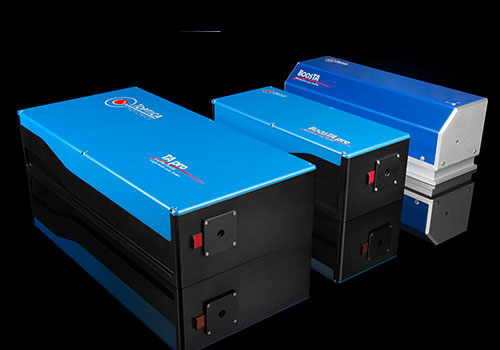



BoosTA pro
- High-Power Tapered Laser Amplifier
- Up to 4 W single mode output power, gain up to 20 dB
- Available wavelengths 660 nm .. 1495 nm
- Compact amplifier module with stand alone driver
- Maintains spectral properties of master oscillator
- Input and output fiber coupling available




BoosTA
- Convenient Laser Amplifier
- Compact and economic optical amplifier
- Wavelength range 660 nm .. 1495 nm
- Gain up to 100, power up to 1.5 W
- Integrated driver concept, most compact
Frequency-Converted Lasers
- Frequency doubling and frequency quadrupling
Nonlinear frequency conversion techniques access wavelengths that cannot be generated directly from laser diode technology. Via second or fourth harmonic generation, TOPTICA laser systems can access the UV, blue, green, yellow and orange spectral ranges at high powers. TOPTICA offers tunable, single-frequency systems at virtually any wavelength between 190 nm and 780 nm, employing ultrastable seed lasers, power amplification in semiconductor or fiber amplifiers, and a proprietary bow-tie cavity design – all in established pro technology. 
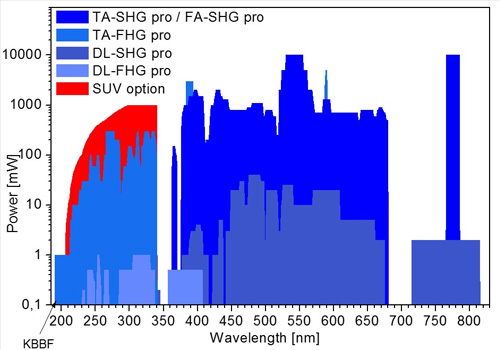

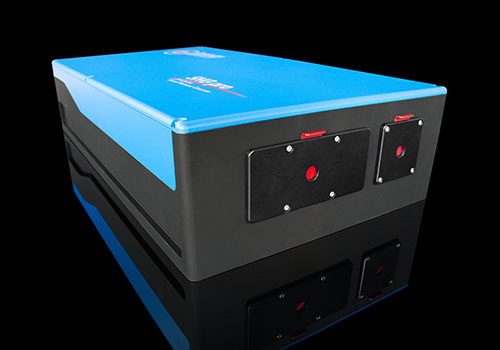




SHG pro
- Frequency-doubling unit
- Compact module for resonant frequency doubling
- Best cw conversion rates
- Wavelengths: 190 .. 800nm, linewidth < 500 kHz
- Highest stability and Ease of Use: pro technology
- For Ti:Sapphire, dye, gas, fiber and diode lasers
The SHG pro is the device of choice if existing lasers are to be frequency doubled. Designed in TOPTICA’s pro technology, it unites highly stable performance and convenient operation. Mirror and crystal holders can be adjusted without opening the resonator cover. A wide range of non-linear crystals covers SHG wavelengths from 190 to 800 nm. TOPTICA offers competent support for adapting the unit to customer requirements.


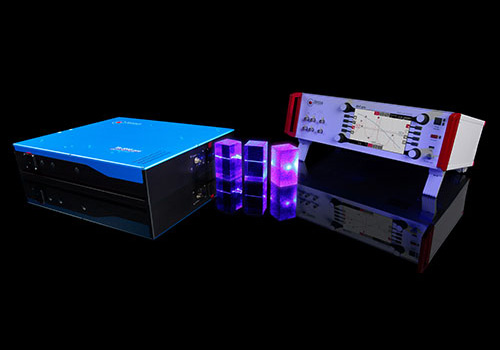



DL-SHG pro
- Tunable, frequency-doubled diode laser with digital control DLC pro
- Resonant frequency doubling stage
- Wavelengths: 320 .. 680 nm, linewidth < 500 kHz
- AutoAlign, PowerLock and FiberMon options
- Digital remote control DLC pro
The grating stabilized diode laser SHG pro is a medium power solution, for applications such as spectroscopy of atoms, ions and molecules, laser cooling and interferometry. Designed in TOPTICA’s proprietary pro technology, it combines best performance and ease-of-use – at moderate initial and operating costs. The system now includes fully-automated push-button coupling optimization into the SHG cavity and the output fiber. The package comprises a solid laser head and a DLC pro control rack. It can be upgraded to a TA-SHG pro, if an appropriate amplifier source is available.

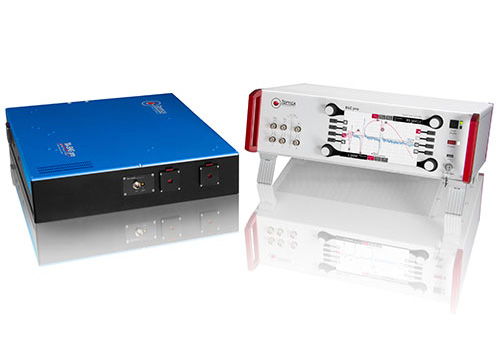




TA-SHG pro
- High-power, tunable, frequency-doubled diode laser
- Resonant frequency doubling stage
- Wavelengths: 330 .. 780 nm, linewidth < 500 kHz
- AutoAlign and FiberMon options
- PowerLock output power stabilization
- Digital control DLC pro with PowerLock
The TA-SHG pro system, part of the UV / RGB solutions, comprises a tunable diode laser, a high power semiconductor (TA) and an integrated frequency doubling stage (SHG pro). Alternatively, it is available with a fiber (FA) or Raman fiber (RFA) amplifier. The SHG stage is a folded ring cavity in bow-tie configuration with excellent thermal and mechanical stability. The system now includes fully-automated push-button coupling optimization into the TA chip, the SHG cavity and the output fiber, as well as output power stabilization. It provides tunable laser radiation for spectroscopy, laser cooling, optical data storage, holography and interferometry.

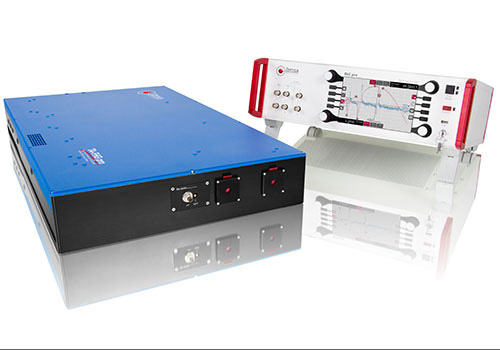
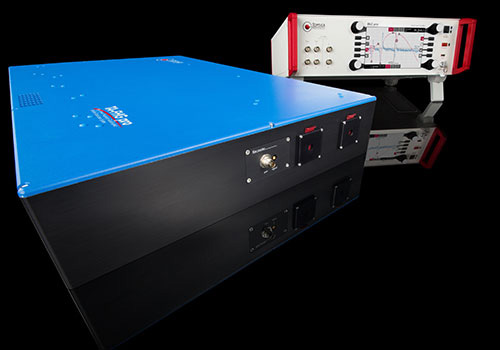



TA-FHG pro
- High-power, tunable, frequency-quadrupled diode laser
- Two resonant frequency doubling stages
- Wavelengths: 190 .. 390 nm, up to 500 mW
- SUV-option - unprecedented DUV power & lifetime
- Digital control with AutoAlign and PowerLock






TOPO
- Widely Tunable High-Power Continuous-Wave OPO Laser
System
- 1.45 - 4.0 µm (2500 - 6900 cm-1)
- 300 GHz (10 cm-1) mode-hop-free tuning range
- Narrow linewidth: 2 MHz (1·10-5 cm-1)
- Hands-free motorized tuning
- Easy all-digital DLC pro control
Laser Driving Electronics
- Digital and analog modules
Apart from a well-engineered optomechanical design and the integrated laser diode, the most important part of a tunable diode laser system is its driving electronics, which is responsible for getting the most out of a laser system.
Wide mode-hop-free tuning with Littrow setups requires a well-defined interplay between piezo actuator and current driver. Drifts of the laser diode current, the temperature or the piezo voltage determine the drift of the laser frequency and the stability against mode-hopping. Noise on any of these outputs increases the laser linewidth. The digital DLC pro represents the latest stage of development of laser control electronics. Its noise and drift properties are even better than the well established and widely used preceeding electronics SYS DC 110. 











DLC pro: Digital Control
- All-digital controller for tunable diode lasers
- Extremely low noise & precise control
- Convenient local and remote operation
- Intelligent locking features
The DLC pro is a platform driving all tunable diode lasers of TOPTICA: One controller for all wavelengths.
The performance of diode lasers is largely determined by its controller. The DLC pro is the first diode laser controller based on a digital foundation, which is essential to obtain the best performance on all key parameters: Low current noise for narrow laser linewidths, excellent temperature control for stable operation and precise piezo control for frequency tuning.



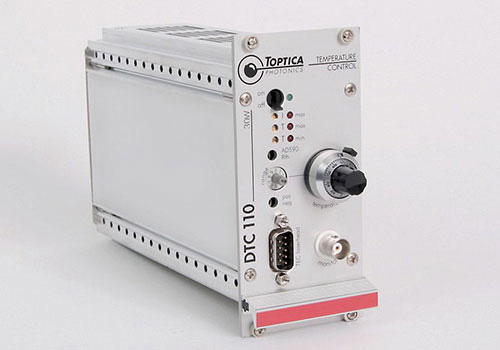

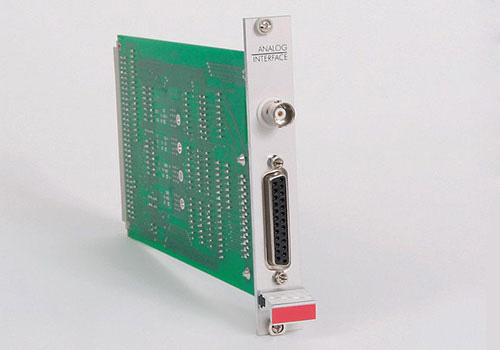






SYS DC 110: Analog Control
- Well-established analog driving electronics for
tunable diode lasers
- Supply rack with linearly regulated, low noise power supply
- Low noise and drift current, temperature and piezo drivers
- Supports numerous modules for laser stabilization
- Modular setup for driving and locking various laser systems
- All important controls directly accessible on front of modules
Laser Locking Electronics
Laser Locking Electronics
- Intelligent solution for versatile laser locking
TOPTICA provides exceptionally stable tunable diode lasers that feature narrow linewidths. Still, many demanding applications have even more rigorous requirements. To reduce remaining frequency fluctuations or cancel out long-term frequency drifts, active frequency stabilization, or "locking", is required.
Picosecond / Femtosecond Fiber Lasers
- Next generation ultrafast fiber lasers for science
and industry
Ultrafast technology has seen an unpredictable success ever since it was introduced. Many promising applications have emerged benefiting mainly from the high peak power and ultrashort pulse duration which give rise to nonlinear effects and open new paths in engineering and scientific research.
The key for successful integration of ultrafast technology are robust, cost-effective systems with simple push-button operation. TOPTICA offers several products fulfilling these requirements: ultrafast fiber lasers based on Erbium (Er) and Ytterbium (Yb) like the FemtoFiber smart, FemtoFiber pro, FemtoFiber ultra and FemtoFiber dichro series. All these systems are based on TOPTICA FemtoFiber technology.
TOPTICA’s FemtoFiber lasers provide reliable femtosecond / picoseconds pulses based on polarization-maintaining fibers and SAM mode-locking. Different models (1560/780 nm, VIS/NIR tunable output, IR/NIR supercontinuum, short-pulse) cover a wide range of applications, e.g. non-linear microscopy, two-photon polymerization, time-domain Terahertz, attoscience, and as seed lasers. 







FemtoFiber smart
- Compact and efficient fiber lasers
The FemtoFiber smart family is TOPTICA’s new series of ultrafast fiber lasers available as picosecond or femtosecond versions, based either on Ytterbium-doped or Erbium-doped fiber laser architecture. These systems are dedicated to applications ranging from seed laser purposes, biophotonics to terahertz generation and two-photon polymerization. Optimized for a compact footprint uniting optics and electronics in one box, these robust all-fiber lasers are the perfect choice for flexible OEM integration.- SAM mode-locked all PM fiber setup
- User friendly turnkey operation
- Robust and reliable, compact design
- Optics and electronics in just one box
- 12V DC power supply with lowest power consumption




FemtoFiber pro
- Versatile, Powerful, High Performance Femtosecond
Fiber Lasers
The FemtoFiber pro is the successor of our proven FemtoFiber Scientific (FFS). The FemtoFiber pro includes a different mode-locking mechanism based on saturable absorber mirrors (SAM) and the use of only polarization maintaining (PM) fibers. Both novelties increase the robustness and reliability of the fiber laser even further. The FemtoFiber pro is available with fundamental output at 1560 nm (FemtoFiber pro IR) and also with second harmonic output at 780 nm (FemtoFiber pro NIR). The latter system versions are integrated in the same housing as the laser with a footprint of only A4. Another system version in the same housing is the generation of a supercontinuum which spans more than an octave in the frequency domain (FemtoFiber pro SCIR). The combination of high pulse energies with very short pulse widths gives the highest peak powers on the market (regarding Erbium doped fiber lasers). The FemtoFiber pro IRS adds a powerful short-pulse model at the fundamental wavelength (1560 nm) and the FemtoFiber pro SCYb provides more than 500 mW at 1030 nm with < 100 fs pulse duration.- SAM mode-locked all PM fiber setup
- User friendly turnkey operation
- Robust and reliable, compact design
- Unique wavelength coverage
- Multi-color synchronized outputs








FemtoFiber ultra
- High-power ultrafast fiber lasers
The FemtoFiber ultra series is TOPTICA's third generation of ultrafast fiber lasers. These lasers provide powerful femtosecond pulses with a ultra-high reliability. The systems use SESAM-mode locked ring fiber oscillators (patented design), followed by a high-power fiber amplifier. For reaching highest reliability levels, only polarization-maintaining fibers are used. All of this is integrated in a unit with a footprint of 25 x 38 cm². The laser systems are easily controlled via Ethernet or USB. A simple graphics user interface (GUI) enables user-friendly access to all laser parameters.
The FemtoFiber ultra series shares the advantages of TOPTICA’s previous ultrafast fiber laser generations. The systems are compact lasers that work reliably after a push-button start. No water-cooling is required since simple air-cooling is sufficient for stable operation. These cost-effective and compact laser solutions provide femtosecond pulses with high average power and excellent beam quality. They are great solutions for applications in nonlinear microscopy like effective two-photon excitation of fluorescent proteins and SHG based contrast mechanisms.- SESAM mode-locked ring fiber oscillator
- Patented design (US 8,457,164)
- High-power fiber amplifier
- Polarization maintaining fibers only
- Compact air-cooled systems






FemtoFiber dichro
- Versatile two-color femtosecond laser systems
The new FemtoFiber dichro series simultaneously generates two perfectly synchronized laser beams at different wavelengths. This new concept provides a compact and easy-to-use laser system which requires no more than the push of a button for laser operation.
TOPTICA’s first laser system based on this novel platform is the FemtoFiber dichro midIR, which uses this new approach to generate a broadband mid-infrared spectrum. The Er-doped fiber laser based system provides broadband laser pulses that are tunable in the range of 5 - 15 μm. The mid-infrared pulses are generated in a difference frequency process (DFG) between a 1.5 μm fundamental source, and a 1.7 - 2 μm supercontinuum source.- SAM mode-locked all PM fiber setup
- User friendly turnkey operation
- Robust and reliable, compact design
- Two-color synchronized output
- Semi-automatic time-delay adjustment




FemtoFiber customized
- Tailored Laser Systems for Specific Applications
TOPTICA’s femtosecond fiber laser systems support a multitude of exciting applications ranging from time-resolved microscopy and spectroscopy to sophisticated pump-probe measurements like ASOPS (Asynchronous Optical Sampling), CARS (Coherent Anti-Stokes Raman Spectroscopy), or SRS (Stimulated Raman Spectroscopy).
To meet the broad range of requirements, the FemtoFiber product line is designed with maximum flexibility and compatibility, which enables the design of complex systems and highly customized solutions.
The key behind TOPTICA’s fiber laser technology is the possibility to link different laser amplifiers to a common master oscillator. The optical parameters of each amplifier can be entirely customized regarding wavelength, spectral width, pulse duration, output power, and repetition rate. With that tailored, phase-locked femtosecond laser pulse trains can be generated that are synchronized to one another with attosecond precision. TOPTICA has now expanded its capabilities by introducing a dedicated department for highly customized solutions that provides tailored fiber laser systems for novel applications in ultrafast optics.
Terahertz Systems
- Optoelectronic Terahertz-Generation
TOPTICA provides complete systems and components for both time-domain and frequency-domain terahertz generation. For time-domain applications, the TeraFlash pro sets new standards in terms of dynamic range, bandwidth and measurement speed. Combining TOPTICA’s FemtoFiber smart laser technology with state-of-the-art InGaAs antennas, the system achieves a peak dynamic range of more than 90 dB and a bandwidth greater than 5 THz. The Imaging Extension enables researchers to exploit the full potential that the combination of time-domain imaging and spectroscopy has to offer.
The new TeraFlash smart uses two synchronized femtosecond lasers and a proprietary scanning scheme (electronically controlled optical sampling, ECOPS) to achieve extremely high measurement speeds: the system acquires up to 1600 complete pulse traces per second.
For researchers working with GaAs-based photoconductive switches or with organic-crystal emitters, TOPTICA provides a variety of ultrafast fiber lasers, all of which come with superior specifications. Owing to the use of robust saturable absorber mirror technology for mode-locking, all lasers offer turnkey operation and do not require any mechanical alignment. Frequency-Domain
- Versatile
solutions for state-of-the-art terahertz measurements
For frequency-domain terahertz spectroscopy, TOPTICA offers two "TopSeller" systems – TeraScan 1550 and TeraScan 780. Based on precisely tunable DFB lasers, digital control electronics, and latest GaAs and InGaAs photomixer technology, the TeraScan systems combine ease of use with best-in-class specifications.
A set of modular product packages extends the cw-terahertz product portfolio: The TeraBeam, a sub-system of the TeraScan, comprises two Distributed Feedback diode lasers with fiber-optic beam combination and digital driver electronics. The Tuning Range Extension pushes the useable bandwidth out to almost 3 THz, and the Phase Modulation Extension features two fiber stretchers for fast and accurate scanning of the terahertz phase. The packages can be combined and upgraded depending on the requirements of the experiment.
TOPTICA's cw terahertz systems have been developed in cooperation with some of the leading institutes in the world. Push-button terahertz spectroscopy has never been that easy! 





TeraScan
- Frequency-Domain Terahertz Platform
- TopSeller systems for cw-THz spectroscopy
- Includes cutting-edge GaAs or InGaAs photomixers
- Highest dynamic range: TeraScan 1550
- Highest scan range: TeraScan 780
- Digital control electronics DLC Smart






TeraBeam
- DFB Lasers for cw Terahertz Generation
- Two DFB pro lasers + digital frequency control
- Available wavelengths: 780 nm and 1.5 µm
- Difference frequency tuning up to 2 THz
- Frequency accuracy < 2 GHz, minimum step size < 10 MHz
- Computerized frequency tuning via Ethernet






Tuning Range Extension
- Tuning range extensions for frequency-domain terahertz systems
- Third laser head – access to higher frequencies
- Exploits full bandwidth of InGaAs photomixers
- Tuning range up to 2.0 THz or 2.7 THz
- Frequency calibration for each 2-laser subset
- Requires TeraScan 1550 or TeraBeam 1550
TOPTICA is been able to push the frequency limits of frequency-domain spectrometers. Whilst one DFB laser at 1.5 µm offers a tuning range of approximately 600 GHz, a combination of three lasers covers the entire range from DC to 2.0 THz, or – using more elaborate combinations – even up to 2.7 THz. TOPTICA’s “Tuning Range Extension” thus provides access to frequencies that used to be beyond reach with commercial frequency-domain spectrometers.

Phase Modulation Extension
- Phase modulation for TeraScan or TeraBeam
- Resolution booster
- Phase and amplitude information at any frequency
- Enhanced thermal stability due to dual-fiber concept
- Path length modulation up to 3 mm @ 1 kHz
- Requires TeraScan or TeraBeam

GaAs and InGaAs Photomixers
- Emitter/receiver modules for TeraBeam
- Cutting-edge photomixer technology
- GaAs and InGaAs-based emitter/receiver modules
- Fully packaged modules with SM/PM fiber pigtail
- Up to 65 µW output power
- Requires TeraBeam 780 or TeraBeam 1550
Time-Domain
- Pulsed terahertz
solutions
TOPTICA offers complete systems and components for time-domain terahertz generation: The TeraFlash pro sets new standards in terms of dynamic range, bandwidth and measurement speed. Combining TOPTICA’s FemtoFiber smart laser technology with state-of-the-art InGaAs antennas, the system achieves a peak dynamic range of more than 90 dB and a bandwidth of more than 5 THz, within a measurement time well below 1 min.
The TeraFlash smart comprises two synchronized femtosecond lasers, eliminating the need for a mechanical delay. This results enables terahertz-based thickness gauging at unprecedented speed: the system acquires up to 1600 complete pulse traces – and hence, thickness readings – per second.
In addition, TOPTICA provides a variety of ultrafast fiber lasers for researchers working with GaAs-based photoconductive switches or with organic-crystal emitters. All of the lasers come with superior specifications. Owing to the use of robust saturable absorber mirror technology for mode-locking, they offer turnkey operation and do not require any mechanical alignment. 



TeraFlash pro
- Versatile time-domain terahertz platform
- Peak dynamic range > 90 dB
- High bandwidth > 5 THz
- Fiber-coupled InGaAs antennas
- Best signal quality, short measurement times

Imaging Extension
- Fast and Flexible Imaging Platform
- Measurement speed: up to 16 pixel/sec
- Flexible configuration in transmission and reflection mode
- Horizontal and vertical profiles of the image provided
- Data filtering in both time-domain and frequency-domain possible
An accessory to the TeraFlash pro, the Imaging Extension utilizes two precise linear stages to scan a sample through the focus of the terahertz beam. The translational movement is synchronized with the shaker of the TeraFlash pro, resulting in a high measurement speed of up to 16 pixel/sec. A “basic” setup is available for researchers who wish to use their own optical components, and a “complete” version includes parabolic mirrors for beam shaping and focusing.




TeraFlash smart
- Ultrafast Time-Domain Terahertz Platform
- Fast measurements of complete terahertz waveforms: 1600 pulse traces / sec
- Proprietary and patented ECOPS technology
- Robust design, no mechanical delay line
- Time-domain dynamic range: > 50 dB single-shot, > 80 dB in 1 s
- Spectral bandwidth: 3 THz single-shot, 4 THz in 1 s
TOPTICA’s TeraFlash smart utilizes a proprietary scheme dubbed ECOPS ("electronically controlled optical sampling"). The system comprises two synchronized femtosecond lasers, eliminating the need for a mechanical delay. This results in extremely high measurement speeds: the TeraFlash smart acquires 1600 complete terahertz waveforms per second, enabling terahertz-based thickness gauging at unprecedented speed. The system thus lends itself to measurements on rapidly moving samples, e.g. conveyor belts, papermaking machines, or extrusion lines.








TeraSpeed
- Superfast Terahertz Screening Platform
- Extremely fast measurements of terahertz pulse intensities (patent pending)
- Photoconductive terahertz emitter + high-bandwidth Schottky receiver
- Digital output: Data rates up to 500 kS/s, “snapshot” and “continuous” measurement modes
- Analog output: Detection of individual terahertz pulses @ 100 MHz repetition rate
- Robust setup without any delay stages or mechanically sensitive
components

Photoconductive Switches
- Compact modules for pulsed terahertz generation
- Fiber-Coupled InGaAs Antennas
- SM/PM fiber pigtail and Silicon lens included
- High terahertz power: typ. > 30 µW
- High bandwidth > 5 THz
- Core components of TeraFlash pro and TeraFlash smart
Pulsed terahertz generation with leading-edge technology: InGaAs antennas provide about 30 µW power and a bandwidth of more than 5 THz. The emitter and detector modules, developed by Fraunhofer Heinrich-Hertz Institute (Berlin/Germany), feature a strip-line and a dipole antenna, respectively, and are packaged with a Silicon lens and SM/PM fiber. They make up the core component of TOPTICA’s TeraFlash pro and TeraFlash smart, but are available as individual modules too.
Difference Frequency Comb (DFC)
- Compact, robust, high-end
TOPTICA’s frequency comb product line uses TOPTICA proprietary CERO-technology which is based on Difference Frequency Generation (DFG). It is inherently fCEO-stable and is characterized by a high robustness combined with high-end performance. 
DFC CORE / DFC CORE+
- Compact low-noise Frequency Comb
- Based on mode-locked Erbium fiber laser
- Offset-free by difference frequency generation
- Patented CERO (“zero-fCEO”) technology
- CORE unit with 4 or 8 outputs at 1560 nm
- Optional extensions for frequency conversion






DFC Wavelength Extensions
- Wavelength conversion from 1560 nm to 420 - 2200 nm
- Modular extensions
- For use with DFC CORE/DFC CORE+
- Upgrade at any time after purchase
- Independent remote control of different extensions

DFC BC / DFC MD
- Beam combiner and monochromatic beat detector
- Flexible beat detection units
- Designed for use with DFC and DL pro
- Stable and compact
TOPTICA's beat detection consists of two flexible modules: DFC BC and DFC MD. Separating beam combination and beat detection into two units allows for placing them at different locations. The DFC BC and DFC MD units are specifically designed for a combination of the DFC with TOPTICA's DL pro tunable diode laser series, but can also be used with other cw lasers.








Complete DFC Systems
- Flexible systems for individual applications
- All from one single source
- Designed to work together
- Easy to use
- Controlled from a single GUI
- Buy a stable, optical frequency
Any of TOPTICA’s tunable diode lasers with a wavelength between 190 nm and 2200 nm can be locked to the DFC, lasers with shorter wavelengths can be stabilized using the fundamental of their SHG unit. The complete laser system is controlled from a single GUI.

Locking Electronics
- Push-button phase-frequency lock
- Robust phase and frequency lock
- Up to 45 MHz bandwidth
- Remote control and locking
- Convenient Software interface integrated into DFC GUI (TOPAS DFC)
- Tunable RF source for offset phase frequency lock
- 10 MHz reference input
- Beat signal conditioning for beat detection and frequency counting
Example: Phase frequency lock of DLC DL pro to DFC
The DFC locking electronics consisting of the Phase Frequency Detector (PFD) and FALC 110 provides high-end phase frequency locking for comb applications. The PFD RF input is designed for use with the RF output signal of the DFC MD. The error signal generated by the PFD is fed to the input of the FALC 110 regulator. The main output of the FALC is passed through the PFD to allow for remote switching of the fast feedback loop which modulates the laser diode current. A copy of the error signal (mon. out) is used to close the slow feedback loop acting on the DL pro piezo (Fine In) with the all-digital PID of the DLC pro. Slow and fast feedback loop can be enabled and disabled with a push of a button in the DFC user interface (TOPAS DFC)

DFC SDL
- Frequency-comb-stabilized laser system
- Rack-mounted
- Complete, stabilized laser systems
- Up to 8 cw-outputs between 420 - 2200 nm
- One central software
Transportable
TOPTICA's offset-free frequency comb DFC (Difference Frequency Comb) and tunable cw diode lasers (DL pro) can be combined into easy-to-use laser systems delivering frequency-stable cw-output at any wavelength between 420 nm and 2200 nm. A complete laser system contains a DFC CORE, wavelength extensions (DFC EXT), cw diode lasers (DL pro), beat units (DFC BC, DFC MD), all necessary stabilization electronics, a wavelength meter (High Finesse), RF-reference, counter, spectrum analyzer, control server (PC) and user software.
Multi-Laser Engines
- Fully Featured Multi-Color Engines
The iChrome family of multi-laser engines addresses the need for lasers with multiple colors in biophotonics (microscopy, cytometry, DNA sequencing etc.) and metrology (scatterometry, ellipsometry). These applications require a flexible laser source that provides several wavelengths from one optical fiber. The compact and reliable iChrome systems thus replace cumbersome and maintenance-intensive “breadboard solutions”.
With TOPTICA’s proprietary COOLAC-technology all integrated lasers can be perfectly aligned with just one push of a button. The light engine can provide up to eight different wavelengths from ultraviolett to infrared wavelengths. The individual lasers are efficiently combined and delivered via single-mode, polarization-maintaining fibers.
With microprocessor-control the iChrome systems enable flexible OEM integration. High speed analog and digital modulation allows for fast switching of laser wavelengths in arbitrary patterns for complex experiments. In addition, the system provides high-end features like direct modulation (no external AOM/AOTF* required), “complete-off” and speckle management, which all can be conveniently controlled via one electrical interface.
TOPTICA's iChrome family thus offers all the features and the necessary flexibility to address even challenging imaging and measurement techniques, either as standalone multi-laser source or fully integrated into existing instruments. At the same time, the system offers easy and convenient operation for beginners and experienced users as well as “no-screwdriver” installation and alignment. 

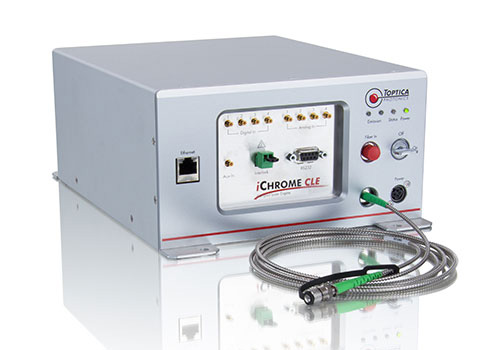



iChrome CLE
- Compact, efficient four-color laser engine
- Four colors in one box
- 405, 488, 561, 640 nm with > 20 mW each
- COOLAC automatic alignment
- Unique modulation capabilities
- Unified user interface
TOPTICA's iChrome CLE is a compact laser engine that combines four laser lines in one box. All integrated colors are provided via one polarization-maintaining single-mode fiber. It is available with 405, 488, 561 and 640 nm and more than 20 mW guaranteed output power after the fiber each. The system guarantees a plug & play installation since it includes TOPTICA's proprietary COOLAC automatic alignment technology.
This way the laser combiner system is ready-to-use after one simple button click. 561 nm laser light is generated by TOPTICA´s proprietary FDDL technology. Each laser line, including the 561nm FDDL, can be directly modulated up to a frequency of 1 MHz and TOPTICA's "Complete OFF" mechanism guarantees zero photons in the "off"-state.












Chrome MLE
- Powerful Laser Engine with 4 Colors
- Perfect choice for Microscopy and Flow Cytometry
- Up to 4 laser lines
- COOLAC – hands free, self aligning system
- Direct modulation up to 20 MHz
- Supported by µ-Manager microscopy software
The iChrome MLE comprises up to 3 different diode lasers and one DPSS laser fully integrated in one compact housing. The individual lasers are efficiently combined and delivered via an all-in-one PM/SM fiber output. The microprocessor controlled system enables flexible OEM integration. High speed analog and digital modulation allow fast switching of laser wavelength and intensity.
TOPTICA’s ingenious COOLAC technology automatically aligns the system with a single push of a button. This feature ensures a constant optical output level even under strongly varying ambient conditions and completely eliminates the need for manual realignment - making the iChrome MLE the most advanced multi-line laser system on the market.
Customized Laser Systems and Solutions
- TOPTICA takes pride in developing customized laser systems and solutions for photonics applications. In close collaboration with several universities and institutes, latest scientific discoveries are frequently incorporated into commercial products. Below you find some of TOPTICA's highly specialized photonics solutions.




SodiumStar
- High-power guide star laser @ 589 nm
- Guide star laser for adaptive optics systems
- Excitation of atmospheric Sodium @ 589nm
- > 20 W cw output power, linewidth < 5 MHz
- 2 W version available for laser cooling of Sodium
- First commercial off-the-shelf sodium guide star laser for astronomical adaptive optics
- Fully integrated turn-key system
- Repumper integration for highest photon return
- Commissioned and in science operation at ESO’s Very Large Telescope and Keck Observatory
The SodiumStar system is a high-power “guide star” laser designed for adaptive optics control in ground-based telescopes. It is based on resonant frequency doubling of an infrared DFB diode laser with subsequent Raman fiber amplifier. More than 20 W are attained at the Sodium wavelength of 589 nm, with a spectral width of 5 MHz. The DL RFA SHG pro, a modified, sub MHz linewidth version with moderate power (2 W) is available for laser cooling experiments.

633 nm High Power
- The diode-based alternative to bundles of HeNe lasers
- 100 .. 150 mW single-frequency output @ 633 nm
- Short-term linewidth < 5 MHz
- Frequency lock to iodine gas cell or HeNe reference
- Frequency stability @ 1 h: ± 10 MHz (± 0.01 ppm)
- Frequency stability @ 1000 h: ± 10 MHz (± 0.01 ppm)
The laser of choice for interferometry, ellipsometry and semicon inspection! TOPTICA has successfully developed a demonstration system of a high-power laser at the classical HeNe wavelength of 633 nm. The system employs mature near-infrared distributed-feedback (DFB) diode technology.

213 nm 10 mW cw
- Test system for cw laser radiation at 213 nm
- 10 mW single-frequency output @ 213 nm
- Short-term linewidth < 1 MHz, coherence length > 150 m
- Passive frequency stability: < 400 MHz/K
- Active frequency stabilization to MHz levels possible
- Low operating cost
The research grade tunable diode laser system DLC TA-FHG pro is an ideal laser for test experiments in scientific or laboratory-like industrial environment (e.g. clean room). While not yet fully designed for 24/7 hands-off operation it comes very close to that. The DLC TA-FHG pro shows excellent passive stability due to patented and proprietary technology as well as a laser head manufactured from a solid metal block.

193 nm sub-mW
- Scientific system for cw laser radiation at 193 nm
- CW output < 1 mW, single-frequency output @ 193 nm
- Short-term linewidth < 1 MHz, coherence length > 150 m
- Passive frequency stability: < 400 MHz/K
- Active frequency stabilization to MHz levels possible
- Coarse tuning range up to 5 nm with severe alignment
We have demonstrated our outstanding cw deep-UV (DUV, i.e. wavelengths below 205 nm) capabilities in several research prototypes and scientific publications. Our general technology portfolio to achieve UV wavelengths is based on two times resonantly frequency-doubling of an amplified external cavity diode laser (TA-FHG pro).
Wavemeters, Laser Diodes & Photonicals
- Broad wavelength selection and useful photonics
tools
TOPTICA offers a large variety of laser diodes (AR-coated, DFB/DBR, Fabry-Perot, Tapered Amplifiers) that are available with a broad wavelength coverage and relatively high output powers - even at exotic wavelengths. Each diode can be purchased separately or integrated into one of TOPTICA's cutting-edge tunable diode lasers.
In addition TOPTICA also provides a selection of Photonicals, i.e. useful photonic tools and accessories. These are helpful devices for photonics and laser laboratories. 



Optical Isolators
- High Power Free-Space Optical Isolators
- Single-Stage TOPTICA Isolators
- Dual-Stage TOPTICA Isolators
- Additional Isolator




Wavelength Meters
- HighFinesse laser measurement equipment
- Unmatched absolute accuracy down to 2 MHz
- Measurement ranges from UV to IR (192 nm .. 11 µm)
- For pulsed and cw lasers
- Sensitivity down to nW light power
- Up to 600 Hz acquisition speed








Photonicals
- Photonic Tools and Accessories
TOPTICA provides a selection of Photonicals – Photonic Tools and Accessories. These are just as important as the laser itself. A modern optical laboratory needs analysis and measurement tools to prepare the laser beam in the requested shape, control its spectral performance, separate it from undesired feedback, etc. TOPTICA offers a variety of accessories to complement your laser source — equipment that in the daily operation of diode lasers is more than useful.








Laser Diodes
- Specify your wavelength – TOPTICA can provide it
TOPTICA offers a large variety of wavelength-selected single-mode laser diodes. Among more standard laser diodes you will also find "rarities", i.e. diodes with output wavelengths that only TOPTICA provides. The diodes can be purchased separately. In addition TOPTICA can integrate any diode from the stock lists into a tunable diode laser system: Fabry-Perot or AR-coated laser diodes may be integrated into a diode laser systems, DFB/DBR laser diodes into a DFB pro and Tapered Amplifier into an TA system.
Each type of diode is carefully tested in an external cavity laser configuration with respect to coarse tuning range, mode-hop-free tuning range and power limits. The results are disclosed on request to the customer in a detailed datasheet. In case you can still not match your wavelength of choice, contact TOPTICA – and chances are very high that we can provide it within very short time.

ToptiCalc
- Calculator for Laser Optics
ToptiCalcTM is TOPTICA Photonics scientific calculator specially designed for use in optics laboratories. We dedicate this helpful calculator to our customers, physicists and engineers, people that work hard in order to make optics and lasers useful for science and industry.It is free and we hope it can help to make some of your calculations easier!
You are a physicist reading a chemistry paper. Why do they always use wavenumbers instead of wavelengths...?
ToptiCalcTM helps you in your everyday laboratory life by offering simple but pratical optics calculations like:- Spectral unit conversion
- Calculating spot sizes for focussed Gaussian beams
- Fabry-Perot calculations
- Reflection and diffraction at plane glass surfaces
- Pulse train calculations
- Short pulse properties and chirp
- Conversion between linear and decibel scale



